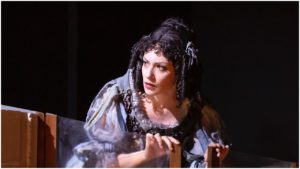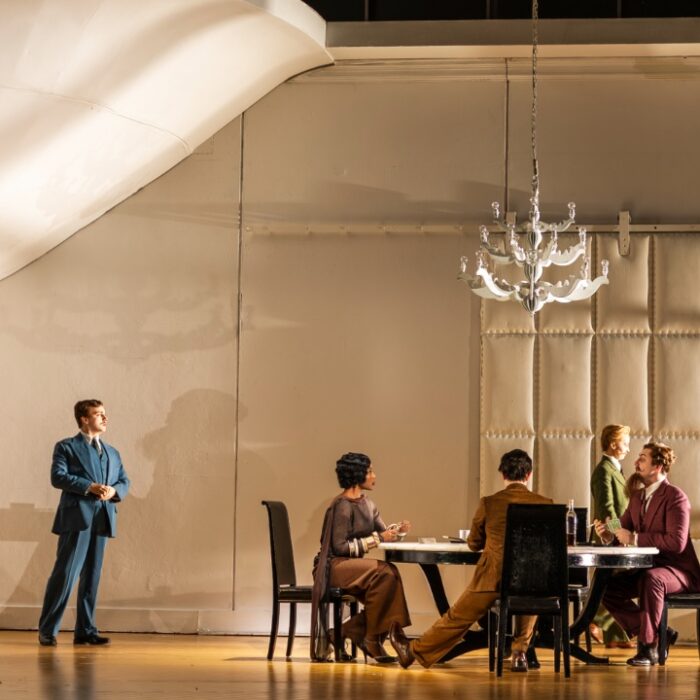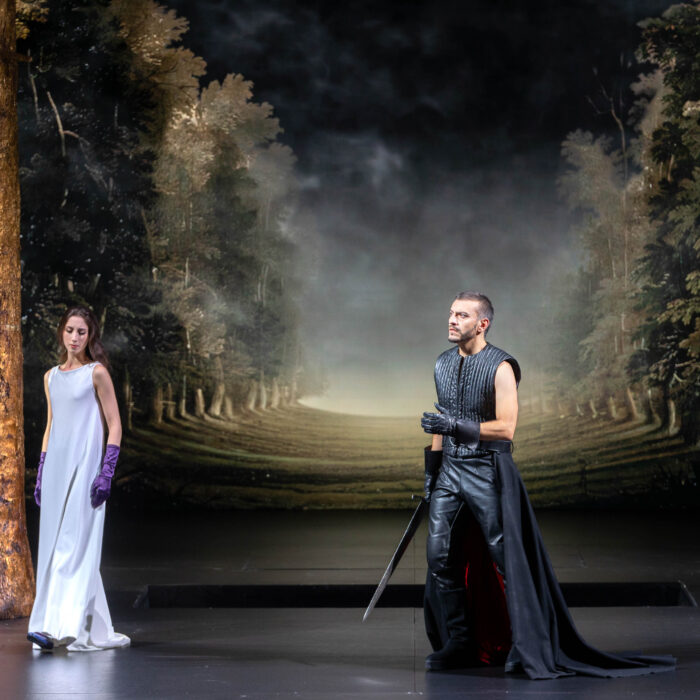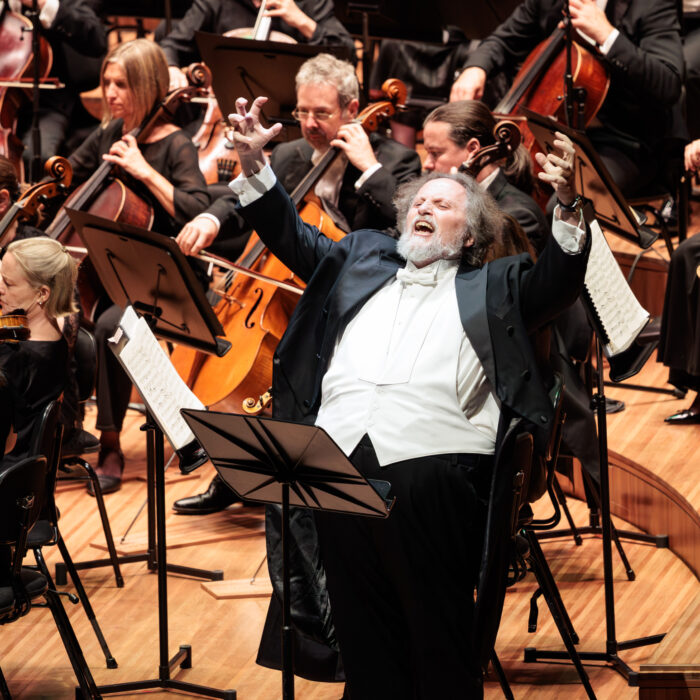
Innsbruck Early Music Festival 2021 Review: Idalma
Arianna Vendittelli Shines Among A Strong Cast
By Alan Neilson(Photo: Birgit Gufler)
Bernardo Pasquini (1637 – 1710) is not a particularly well-known name in opera circles, yet in his day he was considered the foremost composer of dramatic works for the stage in Rome, with his high point coming in the 1670s and 80s, after which he was slowly displaced by, amongst others, Alessandro Scarlatti. As well as 15 oratorios he is known to have composed at least 16 operas, mainly comedies focusing on the lives of normal people, rather than heroes and historical characters. Today, the most well-known of his operas is his commedia per musica in three acts “Idalma” written in 1680 to a libretto by Giuseppe Domenico De Totis.
With its typical far-fetched and intricate plot full of misunderstandings it nevertheless fairly rattles along and has certain elements in common with “Don Giovanni,” notably in the character of the libertine Lindoro who abandons his newly married wife Idalma to court an ex-lover Irene, who now happens to be married to his friend Celindo. Idalma however, remains faithful to Lindoro, even though she is in turn pursued by Irene’s brother Almiro, and eventually wins through, as Lindoro realizes the error of his ways and returns to her, giving the work its alternative title “Chi dura la vince” or in English “Whoever perseveres wins.”
As the Tiroler Landestheater is undergoing renovation work, this production of “Idalma” for the Innsbruck Festwochen der Alten Musik took place in the recently built Grosser Saal of the Haus der Musik. Unfortunately, it does not possess a purpose-built stage for theatrical performances, but rather a raised platform as found in a concert hall, which limited the possibilities for the staging. However, such was the skill and imagination of the director Alessandra Premoli and her team, comprising scenographer Nathalie Deana, costume designer Anna Missaglia and lighting designer Antonio Castro, that the restricted circumstances had no noticeable negative impact. In fact, it proved to be a very effective production indeed.
A Ghostly Costumed Drama Set In The Present Day
Premoli updated the drama to the present day, with the stage transformed into an abandoned house, in which the furniture is covered with dust sheets. Workers and architects wonder about, either preparing the house for sale or readying it for extensive renovation. However, and unbeknownst to them, the house is already occupied. Lindoro, Idalma, and the rest of the cast are the resident ghosts, who trapped in the 17th century, act out the drama whilst also amusing themselves by confusing and frightening the workers.
It was a great idea as it side-stepped the need for scenery changes, and at the same time, the presence of the workers going about their business added to the comedic possibilities, as did the mod cons found in the house, of which Premoli took full advantage. Act two, for example, is brought to an abrupt and amusing end by Celindo cutting through an electric cable when threatening to kill Irene, much to the ghosts’ shock. And having the wall lights flicker brightly in time to Idalma’s excited high pitched coloratura added another humorous touch. It was not slapstick, but it was always amusing and provided the drama with an engaging dynamic.
Missaglia’s colorful and flamboyant cavalier 17th century costumes were perfectly matched to the nature of each individual character and brought color and contrast to the staging.
Vocal Excellence & Convincing Acting Abound
The cast was strong throughout and included a number of excellent performances, in which soprano Arianna Vendittelli led the way in the title role of Idalma. Having recently reviewed some of her recent performances, including her excellent portrayal of Minerva in “Il Ritorno d’Ulisse in Patria” at Florence’s Maggio Musicale, this came as little surprise, such is the consistency of her singing and ability to inhabit a character. However, being in a position to watch her close up, it was fascinating to observe the degree to which her facial expressions reflected her character’s emotions; when angry she looked absolutely ferocious! Indeed, she produced a compelling portrayal of Lindoro’s wife, which was feisty, strong-minded, yet emotionally volatile.
Her singing was also of a high order, in which the beauty of her voice with its exquisitely secure upper register and impressive flexibility, along with her musical intelligence enabled her to capture the emotional depth of Idalma’s character. Her Act two, scene 15 aria “Cieco infante, terror delle sfere” allowed her to show off her agility with a string of trills and coloratura passages, which she molded perfectly to fit her jealous anger.
In scene seven of Act three, Vendittelli, alone on the stage, produced a bravura display in which, cloaking her voice with emotional intensity, she raged and lamented, suffered and despaired, in what was a stunning vocal interpretation. Her animated phrasing was detailed and subtle, full of colorful and accented emphasizes, every line, every word was expressively wrought, and ornamentations and coloraturas were used to further highlight her feelings. Even if this was an emotional rollercoaster, it was not an out-of-control rage, but one interspersed with calmer reflections. It was a dramatically strong scene, which was in no small part down to Vendittelli’s superb performance.
Idalma’s wayward husband Lindoro was parted by tenor Rupert Charlesworth, who produced a larger-than-life, engaging presentation, and displayed a real eye for comedy. His timing was always spot on and his quizzical facial expressions were most amusing. No opportunity was missed for a bit of tongue-in-cheek fun! His vocal characterization was equally well-defined, in which his pleasing timbre and vocal clarity were expertly employed in delivering animated, spirited recitatives. Arias were also given lively presentations, in which Lindoro’s Act three aria “Voglio amar, ma per godere” stood out. Not only does it possess a pleasing melody, but it also showed off Charlesworth’s vocal agility, musical intelligence, attractive timbre, and subtly crafted coloratura.
Last year’s Cesti Singing Competition winner contralto Margherita Maria Sala played the role of Irene. What was particularly noticeable about her performance was how well-balanced the voice sounded. There was no heaviness, her tone was even and warm, which created a sense of equanimity. Even when she exploded in anger, she always appeared controlled and in possession of an underlying calm, and which, moreover, did not compromise her ability to portray the passions. Her clear articulation and delicately molded phrasing were beautifully illustrated in her reflective aria from Act three, scene seven, in which her light coloratura and the gentle lilt of her voice captured the underlying sadness of the piece. If there was a tendency for Sala to err on the side of understatement, the effect on the comedy was all the stronger for it, as on the occasion when angry and frustrated she decides to take it out on the workmen, who unable to see her, have no idea what is happening to them.
Baritone Morgan Pearse produced a well-acted portrait of Irene’s fairly naïve, but sincere brother Almiro. He possesses a strong voice, although he did not always moderate his strength to accord with the other singers so that he created the only noticeable periods of musical imbalance during the performance. There was also a tendency to paint his character with broad vocal brushstrokes, at the expense of detail and subtlety, which carried over into his singing as a whole, in which his coloratura, although full-blooded, lacked nuance. However, in certain respects, his singing was not wholly out of line with the bluff nature of Amiro’s character.
Tenor Juan Sancho as Irene’s husband Celindo looked like a real villain, and acted out the part accordingly, in what was a strong performance. He was jealous, emotionally volatile, and violent, certainly not someone you would want to upset unnecessarily, and deservedly received good-natured jeering at the final curtain. His singing was expressive and clear with an engaging timbre.
In the role of Pantano was bass Rocco Cavalluzzi. He has a strong stage presence which he used to his advantage to draw attention to one of the relatively minor characters. He has a very attractive timbre, which encouraged the audience to sympathize with his character, putting in a clearly defined performance as Lindoro’s servant. His singing was animated, nuanced, and technically accomplished.
Irene’s page Dorillo was played by Anita Rosati, whose bright crystalline soprano impressed. In what as energetic and lively performance, it was her playful duet with Pantano which caught the attention, in which her light, agile, high lying voice contrasted beautifully with Cavalluzzi’s deeper, darker tones.
De Marchi’s Fine Musical Direction
The musical director Alessandro De Marchi elicited an upbeat and high-spirited reading from the Innsbrucker Festwochenorchester, which fully engaged with the dramatic flow of the work, and successfully captured its pervasive humor. The sound was crisp, clear, and bright, and the dance-like passages were delivered with a cheerful and vibrant flair. There were many opportunities for the musicians to display their skills, including numerous beautiful virtuoso passages for the concertino. The musical balance with the stage was near perfect, in which the partnership between the singers and orchestra produced a neatly integrated sound.
“Idalma, ovvero chi dura la vinci” was the first of the three operas to be performed at this summer’s Innsbruck Festwochen der Alten Musik, and it proved to be an excellent choice. It had so much to offer with its light, but pleasing and amusing plot, its abundance of strong melodies as well as a fine creative team, who successfully combined to bring the work to life.
The other two operas to be performed at the festival are Johann Mattheson’s “Boris Goudenow” and Telemann’s “Pastorelle en Musique.”



